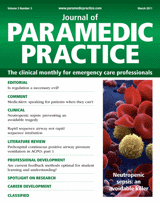References
Pulse oximetry in the pre-hospital setting
Abstract
In order to sustain life respiratory gases are essential. The ability of the paramedic to monitor these gases is key to high-quality, effective, prehospital care. Pulse oximetry provides the pre-hospital care provider with a resource that enables them to monitor patients when they are in the field. The standard method for monitoring peripheral arterial oxygen saturation is pulse oximetry. It is common that supplemental oxygen is given to target levels of oxygen saturation, assisted by the use of pulse oximeters. Other methodologies are available that allow the monitoring of carbon dioxide through capnography and carbon monoxide through CO-oximetry. A pulse oximeter is a non-invasive product that assists the paramedic in assessing the haemoglobin content in a patient's blood.
Pulse oximetry (or SpO2) is not intended to be a replacement for a complete initial and detailed assessment; patient assessment is a hands-on process and is based on establishing a relationship with the patient, not the oximeter. It is a useful adjunct when undertaking assessment and when monitoring patient treatment procedures.
The use of the pulse oximeter has changed medical management and enhanced patient care, the paramedic can assess oxygenation almost immediately and treatment can be initiated speedily. If the paramedic understands the device's function and the principles behind it, this can be a useful tool in providing patient-centred care.
Pulse oximeters do not treat patients; as with any monitoring device, the best monitor is the care provider—the paramedic. The best way to successfully manage any airway condition is to amalgamate the information derived from the oximeter along with a competent clinical assessment; this then enables the paramedic to make safe and effective clinical decisions.
Subscribe to get full access to the Journal of Paramedic Practice
Thank you for visiting the Journal of Paramedic Practice and reading our archive of expert clinical content. If you would like to read more from the only journal dedicated to those working in emergency care, you can start your subscription today for just £48.
What's included
-
CPD Focus
-
Develop your career
-
Stay informed

